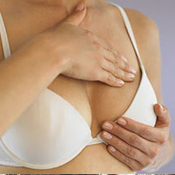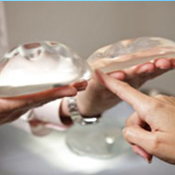!


Mammoplasty (Breast Augmentation)
Mammoplasty, also popular as breast enhancement, is an aesthetic surgery which includes a number of procedures such as breast augmentation, breast reduction and breast uplift. Breast augmentation is up-to-date the most commonly performed cosmetic surgical procedure and is applied to enhance the shape and increase the size of woman’s breasts.
Breast enlargement or augmentation mammoplasty is frequently sought by women who consider that the size of their breasts is too small. The surgery is also sought by women whose breasts have noticeably lost their shape and fullness as a result of weight loss or due to recent pregnancy. Besides boost of patient’s appearance and self confidence the procedure can also be used for correcting an asymmetry between the two breasts. Breast augmentation is also carried out for reconstructive purposes especially after a breast surgery such as mastectomy.
Breast lifting or breast uplift, medically known as mastopexy, is a surgical procedure recommended to women that have certain sagging in their breasts. This method of breast enhancement involves various procedures such as lifting the breast tissue, removing skin and repositioning the areola and nipple. Mastopexy can be carried out as a stand-alone operation, or in combination with the placement of breast implants.
Breast reduction or reduction mammoplasty is generally performed for physical relief rather than for cosmetic purposes. The procedure is suitable for women with very large, drooping breast that limit to a greater extent their activities and cause them serious physical and psychical discomfort. The surgical procedure involves reduction of the breasts’ size by excising fat, skin and glandular tissue. The aim is to provide the woman with smaller, regularly-shaped breasts that are in proportion with the rest of the body. Breast reduction is not advisable to women who intend to breast-feed.
Who is a suitable candidate?
If you are physically healthy person with a clear idea about the benefits of a nose reshaping surgery and you have a visible nose disproportion and a proper motivation to have it adjusted, then there is a very good chance for you to be a proper candidate for the procedure. We realize that some of our patients may be after an aesthetic ideal when considering a nose reshaping surgery. An aesthetic rhinoplasty can produce excellent results as long as the patient has realistic expectations about the improvements that can be achieved.
Age is also an important consideration when assessing patient's candidacy for the procedure. Most physicians will refuse to perform the surgery on teenage girls and boys that are still in growth phase. Patient's emotional stability and ability for social adaptation are also major concerns especially when people are in such a young age. An honest and open discussion with the surgeon about the patient's motives for undergoing the nose correction is always advisable.
Who is a suitable candidate?
Undergoing a breast augmentation surgery is a very personal decision and it is not necessary everyone else to understand completely your reasons for it. The most important thing is how you feel about it and realize what aims you want to achieve. In order to make an educated decision please consider whether your expectations are realistic and discuss with your surgeon the results that can be achieved. The most suitable candidates are those looking for an improvement, rather than pursuing a certain ideal. If you are unhappy with the size or the shape of your breasts, if you have undergone a breast cancer surgery or one of your breasts is noticeably smaller than the other and you are physically healthy then you may be a good candidate for an augmentation mammoplasty.
Breast implants
There are two main types of breast implants used– silicone-gel-filled and silicon cased saline (salt water solution)-filled implants. Up to the implants’ shape, anatomic and round-shaped implants are differentiated. The most suitable choice of implants will be determined by your surgeon in accordance with your breast shape and chest structure during your first examination. Permanent or inflatable implants are used in reconstructive mammoplasty augmentation. Although breast implants are tested numerous times for durability and strength, the peripheral silicon layer is still vulnerable to cuts through piercing. A puncturing through a piercing device may cause a leakage of the inside material and the implants will have to be replaced. Women with breast implants may necessitate a more complex mammography method for better screening including the appliance of special x-ray technique and ultrasonography.
The preliminary exam
During your first exam at the clinic your surgeon will asses your overall health and up to the tone of your skin will choose the most proper surgical technique for you. The hospital, the costs and the type of anaesthesia to be used will be detailed to you as well. If the doctor considers necessary a breast lifting procedure may be recommended in addition to the breast augmentation surgery. Make sure that you understand completely the procedure and don’t be afraid to ask questions, share your concerns or discuss openly your expectations with your surgeon. Please also consult your doctor about any possible complications and make sure that you understand all possible risks. If you a regular smoker or intake daily medications or vitamins your physician should be aware of this.
Before the procedure
Prior to the surgery your doctor will inform you about certain smoking, drinking and eating rules that you will have to follow in order to minimize and avoid possible complications or risks. It will be a good idea to take somebody with you who can help you with going out after the first few days following the procedure.
The procedure
The procedure is generally carried out under general anaesthesia and lasts about one-two hours. The surgical incision is usually made at locations where the scars will stay out of sight such as the armpit, or on the folding where the breast meets the chest, sometimes around the areola. The surgeon lifts the breast tissue and the skin to form a pocket where the implant can be inserted – it could be either under the chest wall muscles or right behind the breast tissue. The plastic surgeon is inserting an implant behind each breast thus achieving an aesthetic augmentation.
The insertion of the implant behind the chest wall muscle is believed to reduce the risk of capsule contracture and also represent a minor obstruction for the mammography test. It is also believed that going behind the breast muscle helps avoiding the curve of the implant to be seen through the skin and provides more aesthetically pleasing results. Despite of these advantages when compared to the method of insertion behind the breast tissue, the surgical technique of insertion behind the chest wall muscles could be more painful in the days after the surgery. Upon concluding the procedure the patient may be required to spend one night at the hospital.
After the procedure
Following the surgery you can either experience oversensitivity or some loss of sensation in your nipples’ area. Tiny numb patches may occur around the places of incision. Normally these symptoms fade away with time nevertheless they may remain permanent in some patients. Fatigue and oversensitivity are common symptoms during the first several days after the operation. Alongside with the redness a burning sensation in your nipples could appear but it will fade away within couple of weeks. The swelling in your breast will diminish significantly after the third week and will vanish completely after the fourth or fifth one. Any post operational discomfort can be easily dealt away with medications prescribed by your physician. Any gauzes or dressings applied will be taken off in couple of days. You will need to wear a special support brassiere for a month which will help your breasts to adopt and preserve a delightful and balanced shape.
Recovery
It will be possible for you to stand up and walk after 48 hours following the procedure. You may go back to work normally few days after the surgery. Your surgeon will advise a time frame for going back to work, exercises and daily activities. It will be best to avoid direct breast stimulation i.e. physical contact for a period of two-three weeks. Any scars left will remain hard and pink for at least six weeks. The scars’ size will remain unchanged for almost two months, although they may appear to be somewhat larger once swelling and redness decrease. Even though scars will start fading as time progresses they will not vanish completely. Routine mammography should not be discontinued after breast augmentation operation alongside with regular examinations by the surgeon. This will ensure the early detection and successful treatment of any complications.
Results
The usage of breast implants can significantly increase your bust line by more than one cup size and improve your body contours. Your breasts will appear naturally fuller and regularly-shaped and your body will adopt a curvy figure. These results can be long-lasting depending on the durability of the breast implants used. Every implant has an expiry date which may range from seven to twenty five years. The majority of women who undergo the breast augmentation procedure describe the results as very satisfactory and pleasing. The change in your outer appearance won’t necessarily cause other people to treat you differently however it may have a beneficial effect on your self-esteem.
Complications and Risks
Just like any other surgery, breast augmentation is also associated with certain risks and complications such as discomfort, infection, bleeding or delayed recovery. Following the surgery the body tends to develop a layer around the inserted implant referred to as capsule. Sometimes the capsule may squeeze and displace the implant causing the breasts to appear asymmetric and feel stiff. The discomfort is known as ‘capsule contracture’ and can be treated in a number of ways. In some cases a subsequent surgery may be required to remove and replace the implant with a new one. Very rarely some patients will develop an infection mostly during the first days after the operation. In very few cases some patients endure symptoms resembling immune system diseases like scleroderma or arthritis featuring fever, fatigue, swollen joints and pain in the breasts. There are no evidences and we have no reason to believe that breast implants may impede breast-feeding or cause breast cancer.
